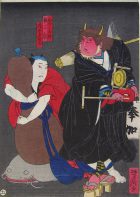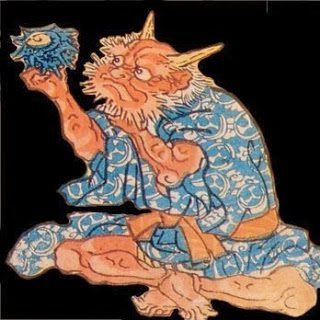Utagawa Yoshitaki and Japan Art: Oni Demon and the Namazu (Giant Catfish) in Folklore
Lee Jay Walker
Modern Tokyo Times
Utagawa Yoshitaki (1841-1899) produced many fabulous pieces of art based on many different themes. His art in relationship to the oni is a fine example of the utter mystery of some of the art pieces by Yoshitaki. This reality is clearly seen by his famous art piece that focuses on the oni (demon) and the namazu (giant catfish).
The oni is waiting to collect more souls in order to take to the pits of hell. Similarly, the namazu is extremely powerful in Japanese folklore based on being a potent harbinger of terrible devastation. After all, if the namazu can break free from the god Kashima then mass uncertainty begins to enter the equation in the realm of nature.
It is believed that once the namazu escapes from the clutches of Kashima then terrible earthquakes or tsunamis will strike. Sadly, this means that the namazu is associated with the deaths of untold numbers because of the ravages of nature. Not surprisingly, the namazu and oni provided Japanese woodblock artists with ample opportunities to exploit Japanese folklore. Therefore, the Edo and Meiji periods witnessed various artists depicting these intriguing mythological figures with so much passion.
The oni in Japanese folklore is very important because this demon waits at the gates of hell for individuals that have done “sinister deeds in this world.” Japanese literature and kabuki also highlight the oni because of all the mystery associated with this intriguing demon. Therefore, in the art piece titled the Oni Demon and Catfish by Yoshitaki he clearly is putting the person depicted in the scene in a terrible dilemma.
Toshidama Gallery says: “This print tells a complex narrative. The figure on the left holds a giant gourd – this was known to be one of the few magical ways to quell the much feared catfish which in the print is lying compliantly underneath. The legends of Japan say that earthquakes and tsunamis are caused by the writhing of a giant catfish (namazu) under Fuji. There were popular prints of the quelling of the catfish (Namazu-e) which appeared after natural disasters such as the Ansei earthquake of 1855.”
I state in another article that: “In this stunning image by Yoshitaki it is clear that the namazu appears unconcerned by the individuals attempt to quell the power it holds according to Japanese folklore. The oni on the other hand looks angry and powerful. It could just be that the namazu knows that the oni is too much for this brave individual who is trying to stop calamity from happening. Therefore, an almost like smirk face persists on the namazu while the oni is impatient because he wants to collect souls in order to take to the pits of hell.”
Of course, an image by itself is always open to major interpretation because nothing is set in stone. According to some individuals the catfish actually does behave strangely before natural disasters therefore Japanese folklore is utilizing this reality. This fact means that the god Kashima must be alert at all times according to Japanese folklore. However, the namazu can’t be contained indefinitely because just like the oni, the namazu is extremely cunning.
https://twitter.com/Toshidama TOSHIDAMA GALLERY
Please visit http://toshidama.wordpress.com for more articles and information.
Please visit http://toshidama-japanese-prints.com/ – On our site you will see a wonderful selection of Japanese woodblock prints for sale. Ukiyo-e (the Japanese name for woodblock prints of the 18th and 19th centuries) are beautiful, collectible and a sound financial investment.
http://www.toshidama-japanese-prints.com/item_428/Yoshitaki-Oni-Demon-and-Catfish.htm
Modern Tokyo News is part of the Modern Tokyo Times group
http://moderntokyotimes.com Modern Tokyo Times – International News and Japan News
http://sawandjay.com Modern Tokyo Times – Fashion
https://moderntokyonews.com Modern Tokyo News – Tokyo News and International News
http://global-security-news.com Global Security News – Geopolitics and Terrorism
PLEASE JOIN ON TWITTER
https://twitter.com/MTT_News Modern Tokyo Times
PLEASE JOIN ON FACEBOOK
https://www.facebook.com/moderntokyotimes
Some Japanese art and cultural articles are republished by Modern Tokyo Times in order to inform our growing international readership about the uniqueness of Japan.


